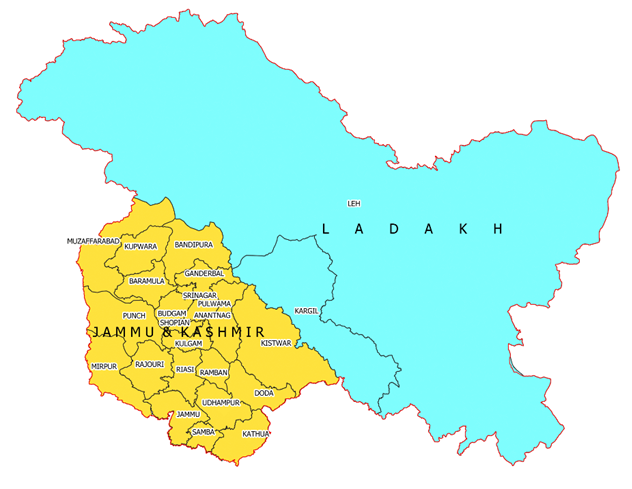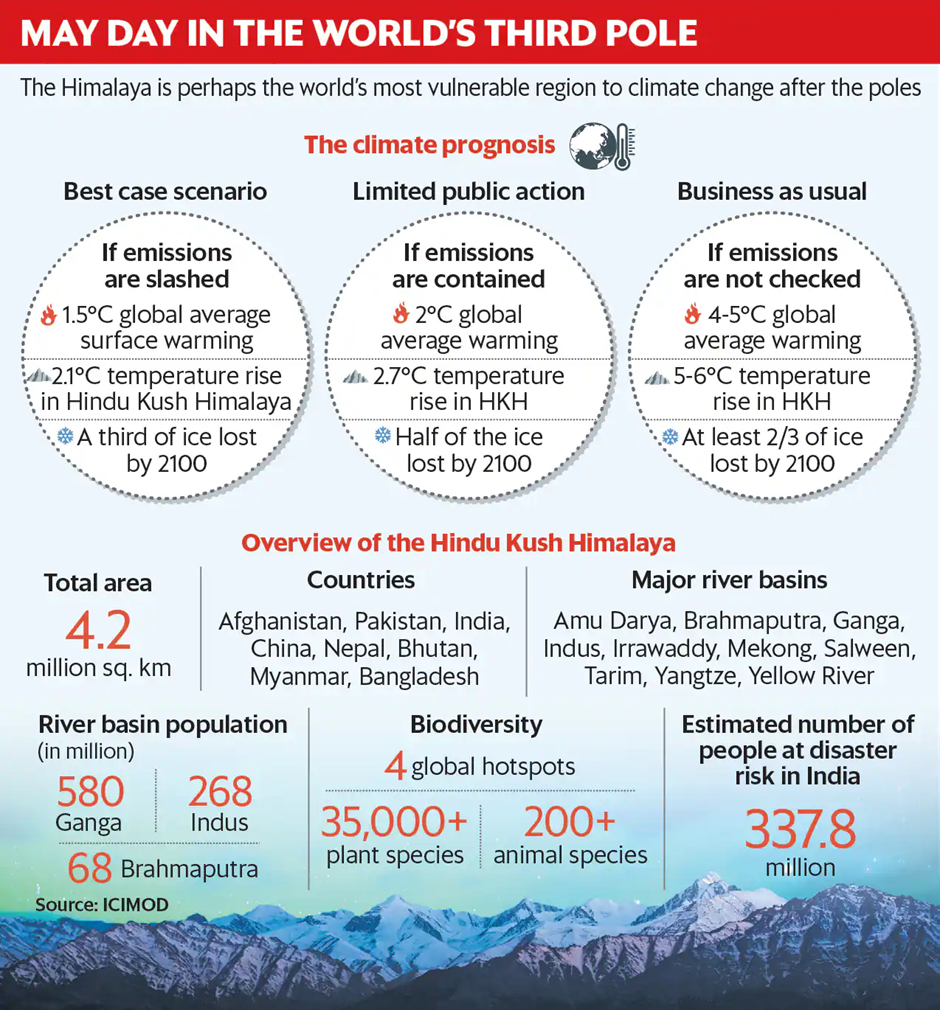A BATTLE TO SAVE LADAKH, AND ALL OF HUMANITY
Relevance: GS 3 – Conservation, environmental pollution and degradation, environmental impact assessment. Disaster and disaster management.
Why in the News?
- Sonam Wangchuk, Ramon Magsaysay award winner (2018) and climate activist, initiated a 21-day climate fast.
- Addressed a 30,000-strong crowd in Leh, Ladakh on March 6, 2024.
- Highlighted the fragility of the Himalayan ecosystem.
- Aimed to raise awareness about climate change issues affecting not only Ladakh but also the world.
Ladakh’s Unique Geographic Context
- Located between India’s neighbours, Pakistan and China, at an altitude of 11,500 feet.
- 97% of the population comprises indigenous tribes.
- Majority lead pastoral lives, relying on farming and animal rearing for livelihood.
Climate Change Challenges in the Himalayan Region
- Faces damaging effects of climate change: floods, droughts, landslides, greenhouse gases, and pollutants.
- The Himalayan region is home to about 15,000 glaciers, often termed the Third Pole.
- Glaciers play a crucial role in the hydrological process, releasing meltwater to major rivers like the Indus, Ganga, and Brahmaputra.
- Threats to Himalayan Glaciers:
- Himalayan glaciers are at risk of melting due to global warming and climate change.
- Melting glaciers will impact both mountain region residents and downstream populations.
Infrastructure Boom and NMSHE’s Role
- The National Mission for Sustaining the Himalayan Ecosystem (NMSHE) was Launched in 2008 under the National Action Plan on Climate Change (NAPCC) by the Centre.
- Managed by the Ministry of Science and Technology.
- Aim: To scientifically assess the vulnerability of the Himalayan region to climate change and monitor the health status of the Himalayan ecosystem.
- After Ladakh became a Union Territory, there was a rapid launch of mega infrastructure projects.
- Projects include:
- Construction of bridges
- Widening of roads
- Tunnels
- Railway lines
- Mega solar projects
- State-of-the-art airport terminal
- Wayside amenities to boost tourism
- Key projects:
- 15 km Zojila tunnel
- 230 km Kargil-Zanskar National Highway
- 10 gigawatt solar energy project covering 20,000 acres in the Changthang region.
Development Policies and Organizations Involved
- Ladakh (UT) Industrial Land Allotment Policy of 2023 aims to make Ladakh a preferred destination for investment.
- Border Roads Organisation (BRO) and National Highways & Infrastructure Development Corporation Ltd. (NHIDCL) are spearheading many of these infrastructure projects.
- NHIDCL’s vision (2021-22 annual report): To fast-track the construction of National Highways and other Infrastructure in vulnerable regions like Jammu and Kashmir, Ladakh, Uttarakhand, and the UT of Andaman & Nicobar islands.
Past Disasters
- 2010 onwards: Series of disasters in the Himalayan region
- 2013: Cloudburst in the upper Himalayas led to flash floods at Kedarnath, causing 6,000 deaths and wiping out several settlements.
- January 2023: Joshimath disaster as water surged down a mountain slope, submerging parts of the town.
- November 2023: International attention drawn to the rescue of 41 workers trapped in the collapsed Silkyara tunnel project in the Himalayas.
- Infrastructure Development in Uttarakhand:
- Infrastructure projects initiated since Uttarakhand’s formation in 2000.
- Projects continue despite warnings from geologists and ecologists.
- Supreme Court of India’s expert committee recommendation:
- Limit the number of pilgrims visiting the Char Dham Himalayan shrines (Kedarnath, Badrinath, Yamunotri, Gangotri) to the carrying capacity.
- Carrying capacity: Maximum number of people an ecosystem can support without degradation.
- Limit the number of pilgrims visiting the Char Dham Himalayan shrines (Kedarnath, Badrinath, Yamunotri, Gangotri) to the carrying capacity.
- Despite warnings, pilgrim numbers have increased annually.
- Some expert committees advise against setting up hydroelectric projects in the para-glacial zone.
Human Cost of Environmental Destruction
- When disasters occur, the impact is felt most acutely by:
- Poor migrant workers involved in ongoing projects.
- Residents, tourists, and pilgrims.
- Government bodies sanctioning the projects and developers executing them are largely insulated from the consequences of environmental destruction.
Ineffective Review and Due Diligence
- Climate Change Activists’ Frustration:
- Recommendations have been largely ignored, even after approaching courts and forming expert committees.
- Minimal due diligence conducted for multi-crore mega projects in the mountains:
- Lack of risk assessment
- Absence of safety measures
- Inadequate geological and seismic analysis
- Development vs. Ecosystem Balance:
- Development should not compromise the delicate balance of the Himalayan ecosystem and its biodiversity.
- Collective responsibility to protect the Himalayas and its inhabitants.
- Wangchuk’s Battle: A Global Concern:
- Sonam Wangchuk’s campaign extends beyond Ladakh and its people.
- It represents a fight for humanity and the wellbeing of future generations.
Solutions to Address the Himalayan Region’s Challenges
○ Conduct comprehensive risk assessments ○ Incorporate safety measures ○ Conduct thorough geological and seismic analyses
○ Adopt sustainable and eco-friendly construction methods for infrastructure projects. ○ Prioritize projects that have minimal impact on the Himalayan ecosystem and biodiversity. ○ Consider the carrying capacity of the region when planning tourism and pilgrimage activities.
○ Involve local communities and indigenous tribes in decision-making processes. ○ Raise awareness among residents, tourists, and pilgrims about the importance of protecting the Himalayan ecosystem. Enhanced Disaster Preparedness and Response: ○ Develop and implement effective disaster preparedness and response plans. ○ Invest in infrastructure that can withstand natural disasters, such as improved tunnel construction and flood-resistant buildings.
○ Educate the public and stakeholders about the environmental significance and vulnerability of the Himalayan region. ○ Promote responsible tourism and pilgrimage to reduce environmental impact.
○ Seek international collaboration and support for conservation and sustainable development initiatives in the Himalayan region. ○ Share knowledge and best practices with other mountainous regions facing similar challenges. |
Mains question
Discuss the challenges and implications of rapid infrastructure development in the Himalayan region in the context of climate change. Give solutions to address the issues. (250 words)





